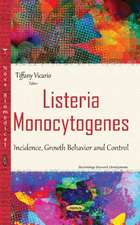Contemporary Trends in Bacteriophage Research
Autor Horace T. Adamsen Limba Engleză Hardback – 18 aug 2009
Preț: 973.60 lei
Preț vechi: 1323.19 lei
-26% Nou
Puncte Express: 1460
Preț estimativ în valută:
186.32€ • 193.80$ • 153.82£
186.32€ • 193.80$ • 153.82£
Carte disponibilă
Livrare economică 25 martie-08 aprilie
Preluare comenzi: 021 569.72.76
Specificații
ISBN-13: 9781606921814
ISBN-10: 1606921819
Pagini: 447
Ilustrații: tables & charts
Dimensiuni: 188 x 265 x 31 mm
Greutate: 1.18 kg
Ediția:New.
Editura: Nova Science Publishers Inc
ISBN-10: 1606921819
Pagini: 447
Ilustrații: tables & charts
Dimensiuni: 188 x 265 x 31 mm
Greutate: 1.18 kg
Ediția:New.
Editura: Nova Science Publishers Inc
Cuprins
Preface; Fighting Fire By Fire- Applying Temperate Phage For Preventing Phage Infection In Food Fermentations; Bacteriophages and the Control of Bacteria in Food; Prophages Within the Bacterial Genomes:Contribution To Bacterial Variability; Inactivation of Viruses With Femtosecond Laser Pulses; Experimental Fitness Landscape For Bacteriophage Infectivity; Bacteriophage Intraspecific Cooperation and Defection; Impact of Phage Properties on Bacterial Survival; Deconstructing Chemostats Towards Greater Phage-Modeling Precision; Disambiguating Bacteriophage Pseudolysogeny: An Historical Analysis of Lysogeny, Pseudolysogeny, and the Phage Carrier State; Impact of Lysogeny On Bacteria With A Focus On Lactic Acid Bacteria; Contribution of Negatively Charged Phosphate And KDO Residues On Lipopolysaccharide To The Binding And Conformational Change of Spike G And H Proteins of Bacteriophage; Mycobacteriophage And Control of Tuberculosis; Contemporary Trends In Bacteriophage Research Bacteriophage Biocontrol:The Ralstonia Solanacearum Case; Characterization of Receptor Sites For Bacteriophages PL-1,J-1 And MLC-A Using Two Strains of Lactobacillus Casei; Usage of Bacteriophage In Display Technology: An Effective Identification of Target-Binding Peptide. Protein From Large Repertoires of Sequences; Index.









